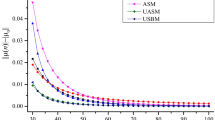Abstract
Regenerative chatter is a self-excited vibration that may take place during milling, which process could shorten the lifetime of the tool and result in unacceptable surface quality. Thus, it is necessary to predict and avoid the appearance of this instability phenomenon. In this paper, an improved complete discretization method is proposed to predict milling stability. The highlight of this algorithm is that, by using Euler’s method, it discretizes periodic coefficient matrices, delay term, time domain term, and the differential terms, In search of convenience, the benchmark examples are illustrated by making a comparison among the semi-discretization method, complete discretization scheme, and improved complete discretization method, while at the same time the accuracy and efficiency of the algorithm is demonstrated. The results show that the proposed method is provided with higher computational efficiency and better industrial application value.
Similar content being viewed by others
References
Tlusty J, Polacek M (1963) The stability of machine tools against self-excited vibrations in machining. ASME Int Res Prod Eng 85:465–474
Tobias SA (1961) Vibraciones en Maquinas-Herramientas. URMO, Spain
Altintas Y, Budak E (1995) Analytical prediction of stability lobes in milling. CIRP Ann Manuf Technol 44:357–362
Merdol SD, Altintas Y (2004) Multi frequency solution of chatter stability for low immersion milling. Trans ASME J Manuf Sci Eng 126:459–466
Insperger T, Stepan G (2002) Semi-discretization method for delayed systems. Int J Numer Methods Eng 55:503–518
Insperger T, Stepan G (2004) Updated semi-discretization method for periodic delay-differential equations with discrete delay. Int J Numer Methods Eng 61:117–141
Insperger T, Stepan G (2011) Semi-discretization for time-delay systems: stability and engineering applications. Springer, New York
Bayly PV, Halley JE, Mann BP, Davies M (2003) Stability of interrupted cutting by temporal finite element analysis. Trans ASME J Manuf Sci Eng 125:220–225
Ding Y, Zhu L, Zhang X, Ding H (2010) A full-discretization method for prediction of milling stability. Int J Mach Tools Manuf 50:502–509
Ding Y, Zhu L, Zhang X, Ding H (2010) Second-order full-discretization method for milling stability prediction. Int J Mach Tools Manuf 50:926–932
Liang X, Yao Z, Luo L, Hu J (2013) An improved numerical integration method for predicting milling stability with varying time delay. Int J Adv Manuf Technol 68:1967–1976
Ozoegwu C (2014) Least squares approximated stability boundaries of milling process. Int J Mach Tools Manuf 79:24–30
Ozoegwu C, Omenyi S, Ofochebe S (2015) Hyper-third order full-discretization methods in milling stability prediction. Int J Mach Tools Manuf 92:1–9
Ding Y, Zhu L, Zhang X, Ding H (2013) Stability analysis of milling via the differential quadrature method. J Manuf Sci Eng-Trans ASME 135:044502–1
Li M, Zhang G, Huang Y (2013) Complete discretization scheme for milling stability prediction. Nonlinear Dyn 71:187–199
Author information
Authors and Affiliations
Corresponding author
Rights and permissions
About this article
Cite this article
Xie, Q. Milling stability prediction using an improved complete discretization method. Int J Adv Manuf Technol 83, 815–821 (2016). https://doi.org/10.1007/s00170-015-7626-9
Received:
Accepted:
Published:
Issue Date:
DOI: https://doi.org/10.1007/s00170-015-7626-9




